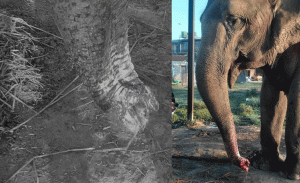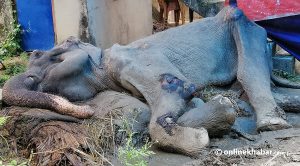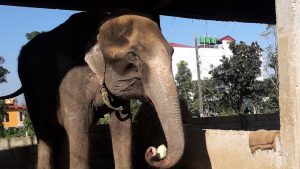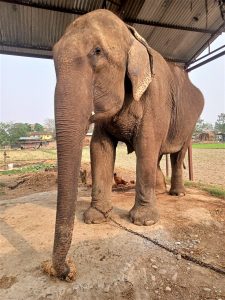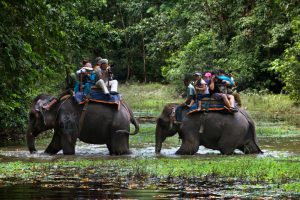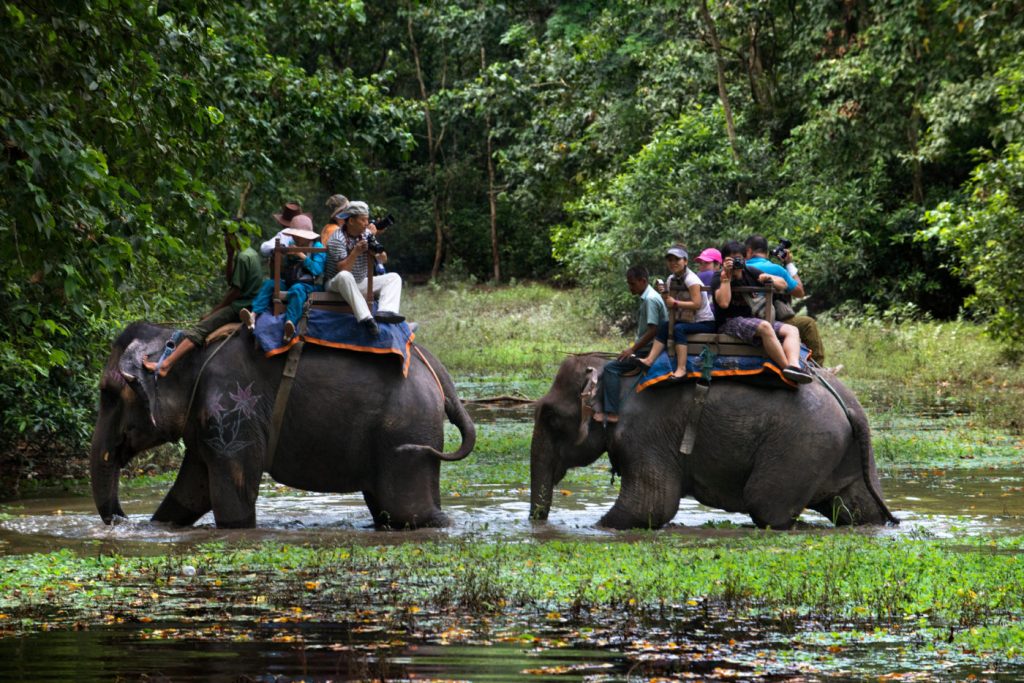
It is 40° C and rising in Sauraha, Chitwan, but there is no respite for Thulo Punamkali, a captive elephant, who stands beneath a shed made of zinc sheets, which is only a few metres higher than her.
The shed is spread around 100 square feet, only big enough to fit her. She eats, poos and pees in the shed itself, which is cleaned once a day by her mahout. When it rains, the water comes in through the side and creates a small puddle that makes it hard for her to sit comfortably. The chains tied to both her front legs and one on her back leg do not help either as she spends her entire day in the heat standing.
It is summer and there are hardly any tourists to take to the jungle, so she spends her entire day chained with nothing to do but eat. Once the tourist season starts after a month, she will be busy giving rides to tourists from as early as 7 am to as late as 6 pm. In between, she gets little to no rest as both Thulo Punamkali and her mahout work tirelessly on an empty stomach.
A few kilometres east is Sano Punamkali, another captive elephant whose shed is a bit larger than Thulo Punamkali. But apart from that, everything is the same. She stands below the hot zinc shed digging the ground and tossing the mud over her body. It is clear she wants to go out, but with no one to take into the jungle, she will spend the next few weeks standing idle in her shed until her mahout takes her into the community forest to get grass.
This is the state of every captive elephant in Sauraha. These elephants only serve one purpose: to serve their owners. During the peak season, they spend their entire time working as owners try and recoup the money they spent on them. The elephants are treated like slaves as they are put to work tirelessly until they can. Once they are no longer able to work, the elephants are sold back to India and new and younger elephants are bought. There have even been cases of elephants being discarded and left to die due to a lack of accountability by all the stakeholders involved. Of late, it has started to raise important questions about what the country is actually doing when it comes to elephant conservation.
When hope died

On June 26, Kajalkali, a captive elephant died near the National Trust for Nature Conservation (NTNC)’s Sauraha office. Many say she died of old age. The postmortem report said she died of tuberculosis, a disease common to elephants. But, mahouts and activists in Sauraha say she died due to lack of care and neglect.
Kajalkali, like all other elephants, was bought from India to work. After years of working, her owner, citing the Covid pandemic, decided to sell her to India. By this time, she started to lose her appetite as her teeth had gone bad and with the elephant not healthy enough, the owner decided to sell her.
But, selling an elephant is illegal. According to the new law introduced to implement the Convention on International Trade in Endangered Species (CITES), to which Nepal is a party, a captive elephant unless registered, cannot be bought or sold. In 2019, the government issued a new directive that made it stricter for elephant trade between India and Nepal that took place easily through the border.
This meant Kajalkali could not be sold. She was taken to the Nepal-India border near Birgunj, but after police received a tip, she was brought back to Nepal and was kept outside Hotel Parkside. The Nepali owner reportedly tried to take her back to India again but failed and after the second try decided to leave the elephant as he had already been paid.
The journey to the border point exhausted the old captive elephant. She fell ill. Her owner in Nepal refused to take care of her as he had already sold her. Her new owner in India was in shock given he had already paid the person in Nepal.
With no mahout, the elephant collapsed time and again. Animal rights activists tried to help. The NTNC says it sent vets to look after her. But, her health did not get better and on June 26, she died.
“She died of neglect. They can say whatever they want, but that is what happened. The government, the cooperative (of elephant-owning hoteliers) and her owners left her to die,” says Surajan Shrestha, an animal activist in Chitwan, “We say elephants are endangered species, but we don’t do anything to protect them. We use them and after they have served their purpose, we leave them to die.”
A lot of people in Chitwan point the blame on the NTNC. But, the NTNC’s Biodiversity Conservation Centre’s chief Baburam Lamichhane says it could not do much.
“It’s easy to say take it in. But, it’s not that easy for us to do that. We don’t have the funds and resources to do that,” he says.
He feels that captive elephants are treated like property and not like endangered species. Some owners, he says, treat them worse than cattle.
Lamichhane also agrees that Kajalkali died due to neglect as she was discarded and urges the government to be more strict when it comes to owning elephants. He also mentions that post-2020, over 20 elephants had been illegally sold to India.
“There is nothing we can do about captive elephants unless the government takes strict measures,” he says.
But, activists feel that such blanket statements from the NTNC are the root cause of the problem as they believe that had there been a rhino instead of Kajalkali, things would have been different.
What made Kajalkali’s death even worse was that she died a few months after Nepal signed a declaration for Asian Elephant Conservation.

We tried to find who the owner was, but no one knew who he was. Or, no one wants to tell. United Elephant Jungle Safari Cooperative Ltd’s president Rishi Tiwari says the captive elephant was a part of the cooperative and after it was found that it was not healthy, it told the owner to not allow Kajalkali on rides.
“It is sad what happened to Kajalkali. But, it was 72 years old and had tuberculosis,” adding that he feels that foreigners tried to spread propaganda when it came to her death. Tiwari says these propagandas are not helping the owners of elephants who are worried about what it might mean for the trade.
“They come and spread propaganda by clicking pictures of our captive elephants and asking for donations. They receive thousands and spend less than 10 per cent of the amount. They are defaming Chitwan and us and we will take action against them,” he says, adding these same people say nothing about hunting animals for fun and sports like bullfighting.
But, Lena Quenard, who has been helping some owners better the lives of the captive elephants, thinks Tiwari’s criticism is unfair. Quenard operates Association Moey, a Swiss non-profit organisation established in 2013, with the mission to help captive working elephants in Asia. Through the organisation, she has even bought an ageing elephant called Lucky Kali who is now retired and lives chain-free in an elephant shelter. She’s also been providing free foot care to these captive elephants and providing education to the mahouts with access to positive reinforcement training.
“I have spent my life savings helping captive elephants and making their lives better along with mahouts. I regularly give them fruits and other supplements that elephants enjoy. I don’t ask for a penny from the owners and still help their elephant, but they still don’t appreciate the work I do,” says Quenard, adding a lot needs to change for the life of captive elephants to be better.
Tiwari does agree there are a few owners who do not take good care of their captive elephants but says people who say that elephant owners do not care are just wrong and do not know the reality.
“These elephants are our property. Don’t people love their homes? It’s the same,” says Tiwari.
But, the reality is different. Mahouts say the owners rarely come to see their captive elephants. The one we met, Gulabkali, is in a sorry state. One of her tusks has come out of her mouth. She drools constantly and cannot even eat without taking breaks as it most likely hurts her.
“She often takes a break from eating and puts her trunk in her mouth because something is hurting her. I’ve told the boss about it as it’s been over two years since she’s faced this, but he doesn’t seem to care,” says her mahout.
Changing ways

Nonetheless, some captive elephant owners have changed. One of them is Dhurba Giri, the owner of Sapana Village Lodge. In 2018, an American guest who had gone on an elephant ride came back to the lodge with tears in her eyes.
“She was heartbroken to see the elephant getting beaten by mahout and came to us asking what she could do,” says Giri.
He suggested she should complain to the park and the government, but that changed nothing.
“I then decided that we would not send elephants out on rides. Instead, we started to offer other activities.”
Sapana Village now has various activities that include walking in the bush with the elephants, gathering food for the elephants, making kuchi (a ball of grass, molasses, salt and rice to feed captive elephants), walking along the river and having different looking over the shelter.
“Many in Sauraha blame me for the lack of elephant riding. They say I killed the tourism product, but they don’t see what is wrong with it,” says Giri.
He currently has six retired and chain-free previously-captive elephants in the shelter.
“They said setting up these chain-free corrals would be impossible and it would be impractical. But, we’ve proved it wrong,” he says.

At Stand Up 4 Elephant, an NGO, Eva and Lhamo are going out for their daily stroll into the jungle. The two elephants who are also retired live chain-free inside an enclosure that is spread across enough land to keep the two happy. Their enclosure includes a big shed to keep both of them safe from the excess heat and rain and also has a small pond. The two also get to go to the community forest every day for four to five hours.
“It keeps them happy. They get to be where an elephant should be. They see rhinos, tigers and other wild animals. They understand it’s their free time. The two are still captive elephants, but we keep them differently,” says Floriane Blot, one of the co-founders.
The team there also started the happy hour with elephants a while back. Renting captive elephants from the owners, she and her co-founder Michael Bailey have conducted hundreds of elephant walks.
“There are risks, but if done well and sold properly, it can be huge,” says Blot, adding the activity was ranked number one on Tripadvisor.
The idea behind these walks was simple: Follow the elephants as they walk along the outskirts of the community forest. But, before this, they also attend an information session about what to expect.

Following the success, the Stand Up 4 Elephant did go to the captive elephant owners and told them it could be done, but Tiwari and others were reluctant as they did not want to stop the cash cow and said Chitwan was not ready for it.
“We aren’t ready for it because it is not a guarantee that what worked elsewhere will work here. It worked for Tiger Tops because they are rich and well-funded. Sapana Village Lodge is also funded by foreigners, but we aren’t,” says Tiwari, who feels walking with elephants in the jungle when there are so many tigers is very unsafe.
Tiwari says the captive elephant owners are up for doing rides with fewer people too but argues that tourism in Chitwan would die if elephant rides are stopped. He also thinks people who tell them beating animals is wrong are missing the point as he feels that if they do not, they will not be able to control them.
But, like the activists, the government authorities are also thinking of discouraging captive elephant rides as they believe that it is not sustainable. Maheshwar Dhakal, the director general at the Department of National Parks and Wildlife Conservation, says the government does not encourage elephant rides as they have been seen negatively and they go against animal welfare.
Nonetheless, he says the government understands the role of elephant rides in the country’s tourism industry. “Yet, it’s not sustainable and we’ve been holding discussions about what we can do to replace it,” says Dhakal.
Sanctuary model

Amid this, Nepali stakeholders have begun to discuss a sanctuary model to manage captive elephants, but there are many problems with such a model. Lamichhane says the major issue is land. Buying private land and keeping elephants is not practical. The national park will not let them do it in the jungle and the locals will make it hard for them to do it in the community forest.
“We can do it in government land, but then, who takes ownership is another issue because someone needs to take ownership of the project if we are to run it properly.”
Lamichhane believes that the NTNC can do it as it has already given services related to elephant welfare and it has support from the government too.
“We at the NTNC look after an 80-year-old captive elephant, Melkali, who is living a good life at the centre,” says Lamichhane.
Tiwari feels the government should start exploring more about the sanctuary model as this seems the most practical model, but this, he feels, should only be for retired elephants. He feels that the government has done nothing to help them so far as their captive elephants cannot even go into the jungle to get green grass.
“Green grass is their right. We need to ensure that our elephants, like those owned by the NTNC, get to go into the forest,” he says.
He feels that if the government does not help them, soon, the country will have no captive elephants as the number of elephants in the cooperative has gone down from 65 to 32 and if things continue, they will have no elephants and tourism in Chitwan will go down significantly.
But, the government feels that this cannot happen as the private captive elephants were bought for tourism purposes alone and it was the role of the owners to take care of their food, shelter and care.
“We can support elephant owners by bringing policies that we think will help both the country and these businesses. But, their demands that we support them is out of place because we have other issues like supporting people whose lives have been affected by wild animals,” says Maheswar Dhakal, the director general at the Department of National Parks and Wildlife Conservation.






